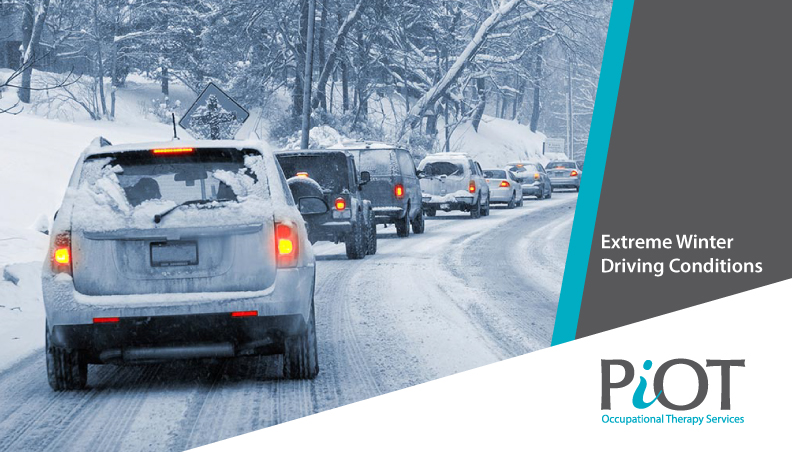
14 Dec Extreme Winter Driving Conditions
We all consider ourselves to be good drivers. That is, until winter conditions hit. Then, some of us can become nervous, cautious or over confident in our driving abilities. We must adapt our driving practices to take into account all that harsh Canadian winters can throw at us, whether it be snow, ice, darkness, low visibility or slippery conditions.
One thing’s for sure- with setting the clocks back in November, most of us won’t be acclimatized to the “new” darkness that impairs both vision and reaction time. And so, in the “doomed” period from 5:00 pm to 8:00 pm, road accidents involving personal injury will escalate.
Also remember, if you do not feel safe driving in extreme conditions, it is OK to stay home. No need to take risks that can easily be avoided. Tomorrow’s forecast should be better.
Transport Canada has provided some tips for safe winter driving. (https://tc.canada.ca/en/road-transportation/stay-safe-when-driving/winter-driving/driving-safely-winter):
Winter driving tips
• Be alert and well rested when getting behind the wheel and always wear your seat belt
• Poor visibility in winter can make driving challenging so it’s important to be vigilant
and alert when driving
• Many winter holidays include parties that serve alcohol or cannabis products. If you
consume any of these products, do not drive. Only drive if you’re sober
• Sometimes, heavy coats and jackets can feel bulky and too warm in a car, especially
during long trips. If you or any of your passengers remove their jacket, remember that
you still need to wear a seat belt at all times. It’s the law
• Bulky winter coats and snow suits may not work well when it comes to your child’s car seat.
Instead, make sure your child is wearing lighter winter clothing so they can be properly
buckled in their car seat with a snug harness and bring an extra blanket to place over them
to keep them warm
See and be seen
• Before you start driving, make sure to remove all the snow from your vehicle including on
the hood, roof, windows, and lights. Clear all windows of frost and fog. This can help you
see better on the road and prevent snow from sliding onto your windshield or on to other
cars while you drive. It could also save you a ticket, since some provinces will issue fines
to drivers that don’t clear all the snow off their vehicles
• If driving becomes too risky, look for a safe place to stop until it’s safe to drive again.
Find a place to safely pull off the road as soon as you can. It’s best to stop at a rest
area or exit the roadway and take shelter in a building
• If visibility becomes really poor, turn on your headlights to make your vehicle easier to
see
Adapt your driving
• Match your speed to the road and weather conditions
• To reduce any risk of accidents, avoid passing other vehicles when weather and road
conditions are poor. When you drive on a snow-covered road, there may be more snow or slush
between lanes, which can make changing lanes harder
Safe braking
Proper braking is important to safe winter driving. Since it takes longer to stop on a slippery road, you should:
• leave more distance than normal between your vehicle and the vehicle in front of you
• pay close attention to the road – as far ahead as you can
• make sure that you don’t release the brake pedal when the vehicle is out of control.
Focus on steering with the brake pedal applied hard
Skidding
Even careful and experienced drivers can skid, so be prepared. Skidding can be caused by panic braking when you’re trying to avoid an obstacle on the road. To reduce skidding in bad weather, you should:
• slow down. Allow extra travel time and be very careful when you brake, change lanes, make
turns, and take curves
• put more distance between you and the vehicle in front of you
• avoid forceful braking or sudden, jerking movement of the wheel
• read the owner’s manual to learn about your vehicle’s braking system and tire traction
If the Electronic Stability Control (ESC) comes on, this means your vehicle is trying to prevent skidding and loss of control. Slow down and drive more cautiously. ESC is standard equipment on vehicles manufactured from 2012 onwards. When the vehicle begins to skid, ESC applies the brakes to one or more wheels, or reduces engine power, or both, to help keep the vehicle under control. If you get stuck, turn off your ESC.
In extreme weather don’t use cruise control. Don’t rely on other driver assistance technologies, like blind spot monitoring or lane keeping assistance, as they may not work in bad weather. Review your owner’s manual to understand the systems’ abilities and limits.
Be prepared to call for help
Keep your phone fully charged and have a charging cable in your vehicle just in case. If you’re in an emergency, call 911.

